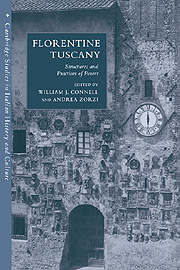Book contents
- Frontmatter
- Contents
- List of figures
- List of tables
- List of abbreviations of archival sources
- Introduction
- 1 The ‘material constitution’ of the Florentine dominion
- 2 The language of empire
- 3 Constitutional ambitions, legal realities and the Florentine state
- 4 Fiscality, politics and dominion in Florentine Tuscany at the end of the middle ages
- 5 Market structures
- 6 State-building, church reform and the politics of legitimacy in Florence, 1375–1460
- 7 The humanist citizen as provincial governor
- 8 Territorial offices and officeholders
- 9 Demography and the politics of fiscality
- 10 Florentines and the communities of the territorial state
- 11 Patronage and its role in government: the Florentine patriciate and Volterra
- 12 San Miniato al Tedesco: the evolution of the political class
- 13 The social classes of Colle Valdelsa and the formation of the dominion (fourteenth–sixteenth centuries)
- 14 Arezzo, the Medici and the Florentine regime
- 15 Rubrics and requests: statutory division and supra-communal clientage in Pistoia
- 16 A comment
- Index
- CAMBRIDGE STUDIES IN ITALIAN HISTORY AND CULTURE
1 - The ‘material constitution’ of the Florentine dominion
Published online by Cambridge University Press: 16 September 2009
- Frontmatter
- Contents
- List of figures
- List of tables
- List of abbreviations of archival sources
- Introduction
- 1 The ‘material constitution’ of the Florentine dominion
- 2 The language of empire
- 3 Constitutional ambitions, legal realities and the Florentine state
- 4 Fiscality, politics and dominion in Florentine Tuscany at the end of the middle ages
- 5 Market structures
- 6 State-building, church reform and the politics of legitimacy in Florence, 1375–1460
- 7 The humanist citizen as provincial governor
- 8 Territorial offices and officeholders
- 9 Demography and the politics of fiscality
- 10 Florentines and the communities of the territorial state
- 11 Patronage and its role in government: the Florentine patriciate and Volterra
- 12 San Miniato al Tedesco: the evolution of the political class
- 13 The social classes of Colle Valdelsa and the formation of the dominion (fourteenth–sixteenth centuries)
- 14 Arezzo, the Medici and the Florentine regime
- 15 Rubrics and requests: statutory division and supra-communal clientage in Pistoia
- 16 A comment
- Index
- CAMBRIDGE STUDIES IN ITALIAN HISTORY AND CULTURE
Summary
It was in 1986 that Gian Maria Varanini invited historians, in their study of the Italian territorial states, to look beyond the phase of ‘accomplished stability’ to a ‘prehistory’ in which the characteristic practices of these states took shape. Convinced that the modes of governing of the Italian states were not new with the fourteenth and fifteenth centuries, Varanini argued that these political structures originated in the communal period: in the experience of establishing control over the countryside and in the development of a hierarchy among the north Italian cities. Seen from the perspective of this communal prehistory, the formation by Florence of a territorial dominion was not an inevitable process, but a process open to different possible paths for development. If, therefore, a linear understanding of political development is abandoned, I should prefer to speak of the ‘material constitution’ of the territorial state. This seems a term well suited to describing the early hierarchy of Tuscan cities and the asymmetries among them that historically preceded the creation of a Florentine dominion.
To anticipate this chapter's conclusion, the Florentine process of expansion took place slowly, and in continual interaction with the territorial expansion of rival states. The ordering of the territory did not follow a unitary scheme, nor was there a progressive refinement of public functions; what took shape, rather, was a system characterised from the beginning by a low degree of integration among its components.
- Type
- Chapter
- Information
- Florentine TuscanyStructures and Practices of Power, pp. 6 - 31Publisher: Cambridge University PressPrint publication year: 2000
- 2
- Cited by



